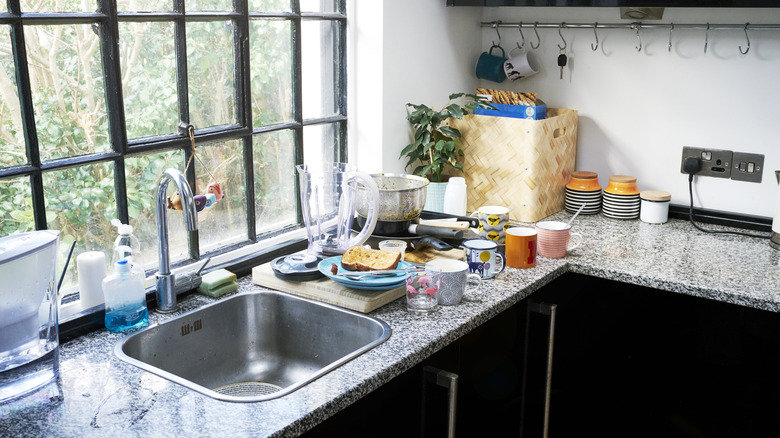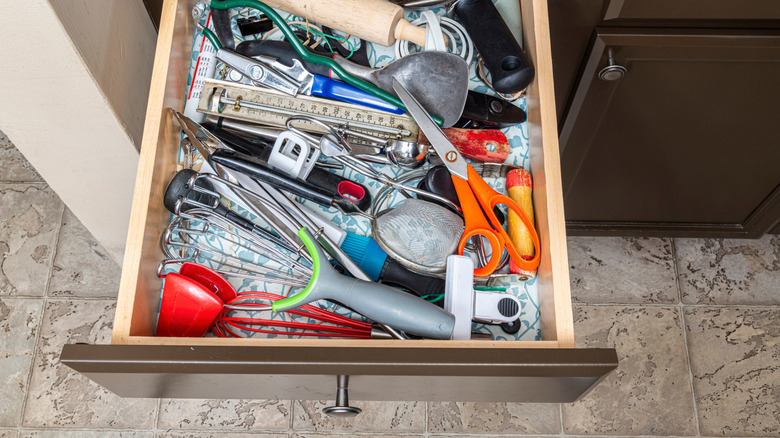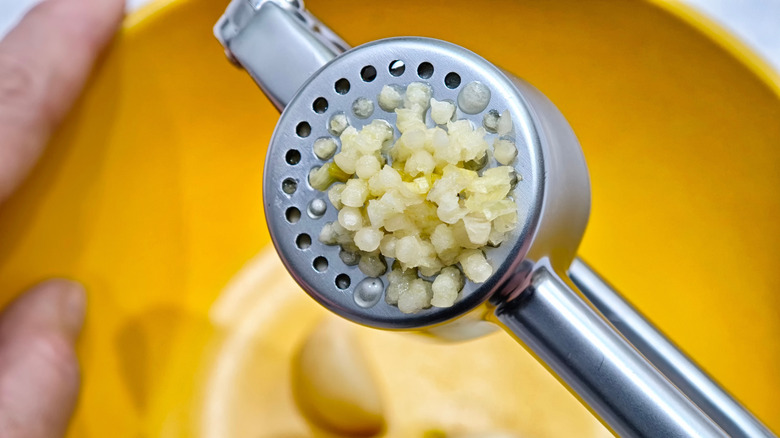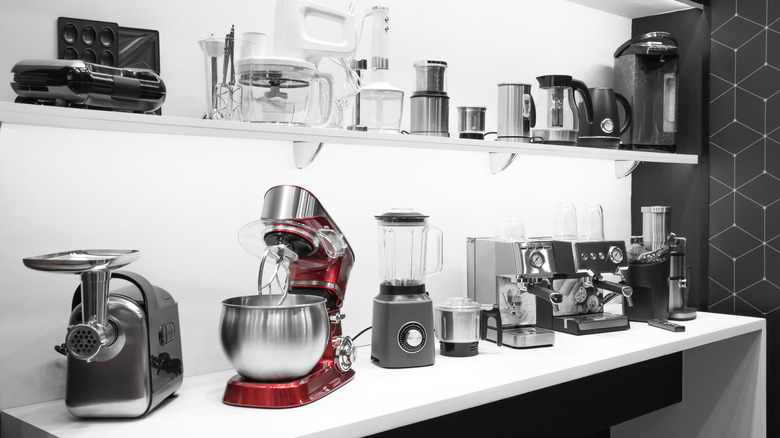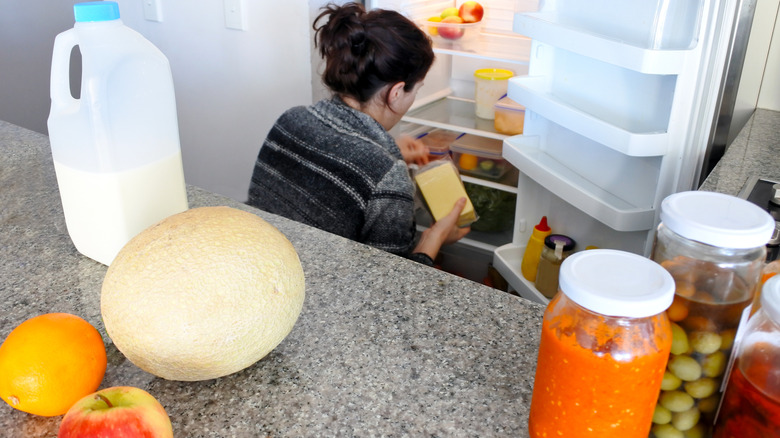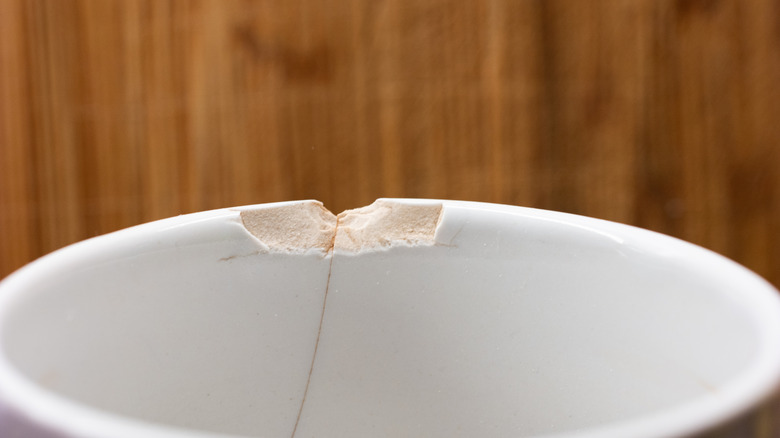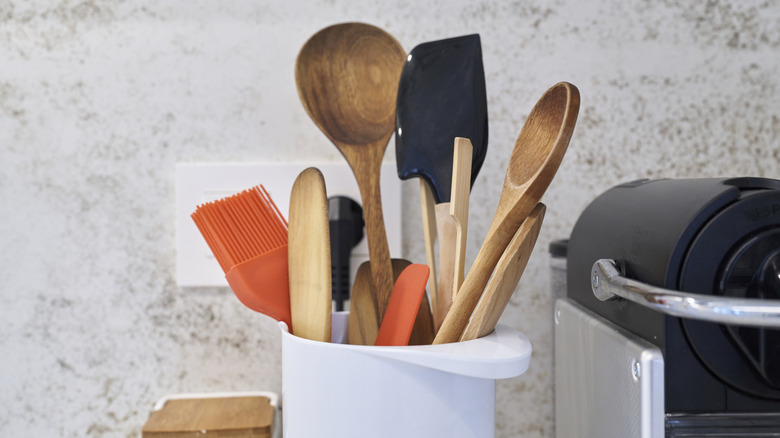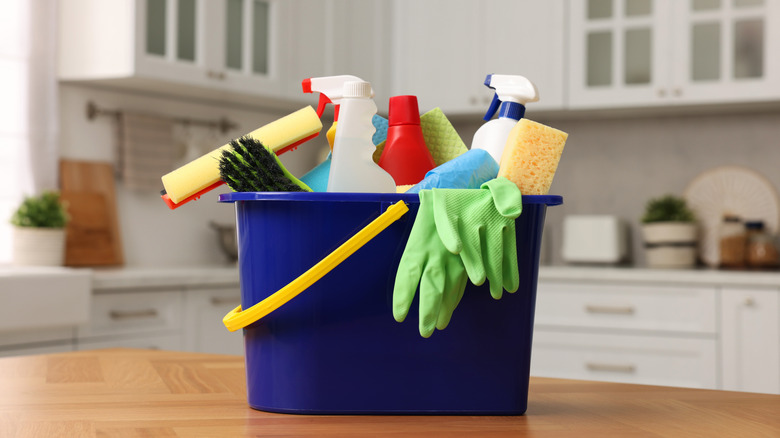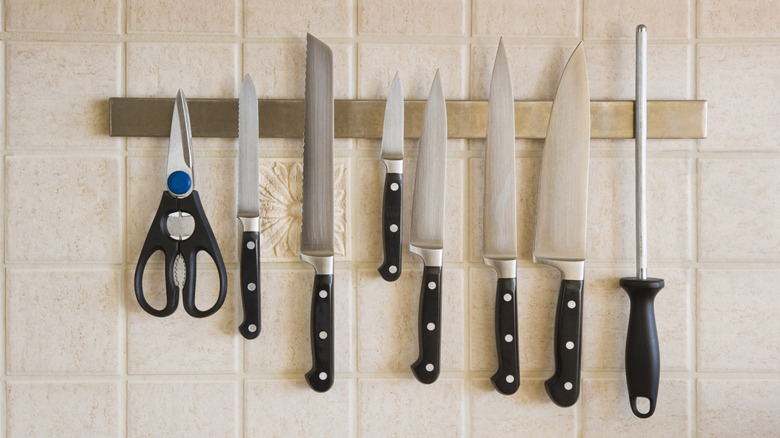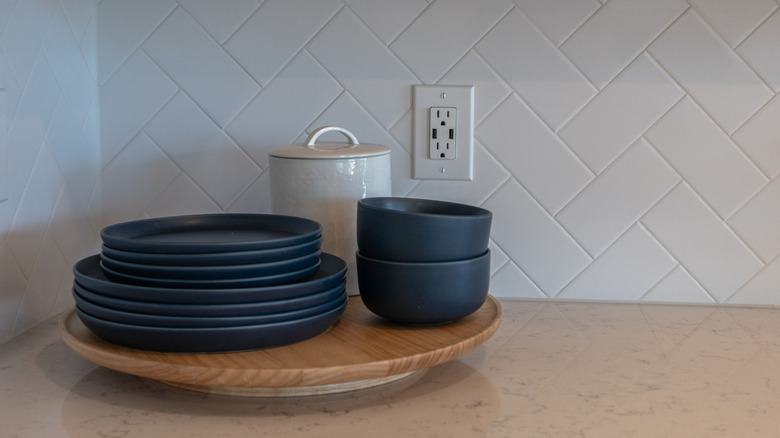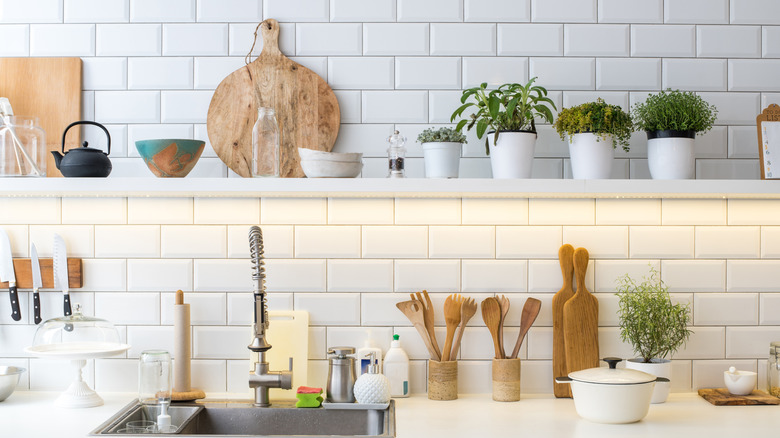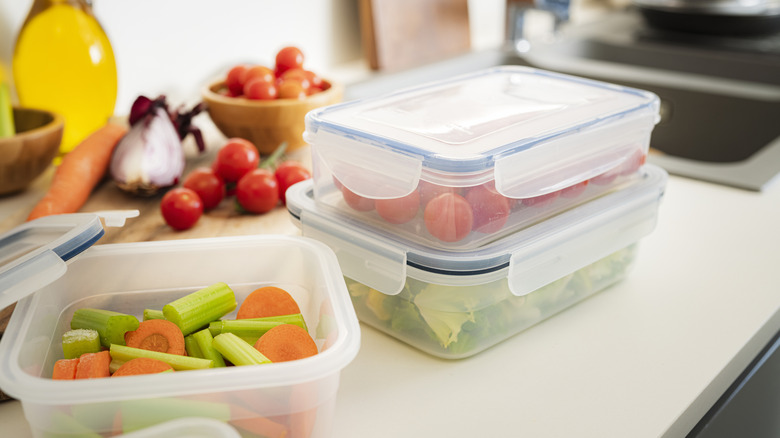The Ultimate Guide To Decluttering Your Kitchen
The kitchen can be a surprisingly difficult space to declutter, so it's no surprise that many people wind up with excess kitchen tools and appliances before they even realize it. This decluttering guide is for you if you've ever asked yourself questions like: Which appliances do I actually need, and which can I get rid of? Should I be decluttering the fridge in the process? How many spatulas should a person even own, anyway?!
To break down what can feel like an overwhelming job into an approachable project, we've rounded up all the steps you should take when you're decluttering, or even downsizing, your kitchen. From appliances to storage solutions, this ultimate decluttering guide will help your kitchen feel fresh, streamlined, and tidy in no time — and will give you a good chance to donate the things you no longer need, too.
First, look for items that don't belong in your kitchen
Plenty of us are guilty of having a "junk drawer" hidden somewhere in our kitchen, but sometimes the clutter finds its way out of that one drawer and into the rest of the room. Your first step when decluttering your kitchen is to search out all the items that aren't even cooking-related. If you've got mail and old receipts in a pile on your counter, jewelry you took off while baking next to the stove, a pair of pliers randomly hanging out, and pet toys scattered around, focus in on those first.
These types of items are the most obvious sign of clutter that your eyes will be drawn; once they're removed, your kitchen will already look a lot cleaner and more organized. Plus, your goal when decluttering your kitchen is to actually be able to focus on your appliances and kitchen tools — without being distracted by extraneous items that need to be put away in other rooms of the home.
Don't forget to also give your junk drawer a little tidy, too (you can even declutter it with an egg carton). You might prefer to keep pens, notepads, rubber bands, and plastic bags handy, but nobody wants to rush to write down a recipe only to find out they grabbed an old pen that's out of ink. There is also a case for ditching your junk drawer altogether, but even if you prefer to keep yours around, you should at least plan on decluttering it as much as possible.
Get rid of your kitchen's uni-taskers
Celebrity chef Alton Brown famously calls any kitchen tool that can only perform one task a "uni-tasker," and recommends getting rid of it to save kitchen space. He's certainly on to something; while some uni-taskers can genuinely make your life a little bit easier (hello, garlic peeler), most of them aren't worth the wasted kitchen space. There are so many kitchen tools that can perform a wide range of tasks instead of just one; once you get rid of your uni-taskers, you'll have more space for the versatile kitchen items that you actually reach for on the regular.
A few uni-taskers you might be guilty of owning include items like a garlic press, margarita machine, or ice cream maker — and yes, these are all items that Brown has named and shamed specifically. When identifying a uni-tasker, ask yourself how often you really end up using it, and whether there's another appliance you already own that could perform that same task. You don't necessarily need to get rid of uni-taskers that make your life ten times easier (a cherry pitter might only have one use, but it's admittedly quite handy, and if you actually use your garlic press, definitely don't chuck it). Pro tip: Look for tools you could easily replace with something else that you already own. Even if you use that margarita machine in summer, could your regular blender do it better? The answer is yes, it probably could. Once you've identified an alternative, it's time to donate all of your uni-taskers you no longer need.
Take stock of what you actually use in one week
Most of us have a dozen tools that are easily accessible within our kitchens, but that we never reach for. To figure out what items you're actually using on a regular basis, take stock of what you do use during a single week. You'll probably reach for your favorite pots and pans, spatulas, knives, and maybe a whisk. But there are likely some kitchen tools that have been given valuable kitchen real estate they simply don't deserve.
Once you've identified the tools you rarely use, it's time to move them. Some tools that we don't use all the time are still a necessity — like a food processor, for example. But instead of keeping these in a kitchen cupboard or drawer and allowing them to get in the way whenever you reach for something else, relocate them to a storage closet or pantry instead. This will give you more space for the things you reach for all the time, without forcing you to get rid of them entirely.
During the week, you might have also noticed some items that you can't ever see yourself using again — and this is a good chance to donate them. After the initial week is over, continue to keep an eye on the items you use and the ones you don't. If you haven't bothered using a certain item within a few months, it's probably time to get rid of it.
Don't forget to clean out your fridge
Your fridge is an essential part of your kitchen, and it deserves its own decluttering while you're busy working on your cupboards and pantry. Don't stop at tossing rotten produce and old takeout containers. Take everything out of your fridge (and give your fridge a good wipe down with vinegar or a cleaner of your choice while it's empty, too) and before you put every item back on the shelves, take a look at the expiration dates. Toss everything that's expired and replace it (this might even help you free up some pantry space, if you stash extras there).
Cleaning out your refrigerator should also give you a good idea of what items you don't use. If the bottle of relish you bought back in 2023 expired without ever being touched, it's probably safe to say you shouldn't bother replacing it. Cutting down on the condiments and sauces you keep in your fridge can help you stay more organized, and save you money.
Check your most-used kitchen items for damage
It's all too easy to keep kitchen items long past their prime; in fact, some can actually be unsafe to keep around. Take a look through your kitchen cupboards for non-stick pans — is the non-stick surface flaking off or scratched? In this case, it's no longer food-safe, and needs to be discarded. If you've got sponges that are older than a week or two, they're probably harboring lots of bacteria, and it's time to replace them. Scour your drawers for rusty can openers, plastic spatulas that are flaking off and leaking silicone into your food, and chipped ceramic baking dishes that are not worth keeping (the chips can harbor bacteria that's practically impossible to clean off).
If you've inherited or thrifted vintage kitchenware, you should also take a closer look at them; some types of vintage items can contain lead and other dangerous chemicals. A chipped vintage baking dish won't just harbor bacteria, but could also leak lead into your food. If you've got a few of these items that are sentimental to you, repurpose them by displaying them or using them as decor; just make sure to remove them from your cookware rotation.
Look into the items you have multiples of
When decluttering your kitchen, it's always a good idea to get rid of items you have several of. There's certainly nothing wrong with keeping a few different spatulas and wooden cooking spoons, but you could consider paring down things like duplicate whisks and strainers. Over time, you might have also accumulated several different versions or models of the same item; it's rare that you'll need multiple of one of each type, so getting rid of any duplicates is an easy way to declutter your kitchen quickly.
But when you focus on getting rid of duplicates, don't just stop at your kitchen tools. Chances are, you're also harboring an extensive mug or reusable water bottle collection, too. There's nothing wrong with collecting a few cute mug designs, but don't leave them all out of the spotlight when you're decluttering your kitchen, either. When you're decluttering your water bottles, check for signs of mold, leakage, chips, missing lids, cracked straws, or severe dents. These are indicators that it's time for the bottle to go. With mugs, discard any that are chipped or cracked, and also consider getting rid of those that you don't enjoy using regularly. Depending on how large your collection is, you might end up freeing up a full cupboard's worth of space.
Get rid of and consolidate your cleaning supplies
Many kitchens have a cupboard for trash and cleaning supplies — if we had to guess, yours are probably kept under the kitchen sink. One essential kitchen decluttering step is to go through all of your cleaning supplies. Take them out of the cupboard and look through them. First, search for expired products you haven't gotten a chance to finish; these can usually be thrown out or dumped down the drain, but if you're unsure, check your local trash collection guidelines. Next, look for cleaning products that you rarely use; these can be discarded or relocated to wherever you keep your other cleaning supplies. Don't forget to check the remaining cleaning supplies for damage; sometimes, products can show signs of trouble even before they expire, depending on how they were stored. Make sure your cleaning wipes haven't dried out, check your liquid products to make sure they haven't solidified, and look for any leaks or cracks forming on any of the containers.
Once you're finished, you should consolidate all of your cleaning supplies into a single caddy or under-the-cupboard shelf. This will help you keep track of your favorite cleaning products (if you don't have any favorites and need some recs, here's our list of the best all-purpose cleaners worth buying for your kitchen). Finally, if you store trash or recycling bags under the cupboard, group them together in a single bag or bin.
Update your kitchen storage to suit your needs
Decluttering isn't just about getting rid of items, but also about finding ways to store them so that they don't look like, well, clutter. Storage solutions don't have to be custom or expensive; there are a few easy changes you can make to your kitchen that will prevent it from looking messy, even after you've gotten rid of items you no longer use. For example, you can start by finding a new way to store your paper towel rolls so they're not out on the counter — consider installing a paper towel rod on the inside of a cupboard door instead. Rather than keeping a knife block on your kitchen island, add a hanging knife organizer to your wall, or use a horizontal knife rack in your kitchen drawer. If you have shelves of spices out and about, relocate them to a kitchen cupboard; you can add a spice organizer to a cabinet or drawer to help keep your jars organized, but out of sight.
If there are any visible spaces that you just can't get 100% clutter-free, try to conceal them as much as possible. For example, you can transform open shelves by adding storage boxes that hide clutter to store all your items inside, hiding everything away. You can do the same for the top of your fridge, too.
Consolidate your countertop items onto one tray
A lot of kitchen clutter comes from your counters, where items that are often left out (such as spice mills, oils, and jars full of cooking spoons) are strewn about, making things look messy. First, clear any appliances you can from your countertops — these should be stored in your cupboards, as you'll be left with more working space. Next, gather together all of the items you want to keep out on the counter so that you can access them easily while cooking. You'll want to grab a tray, small shelf, or lazy Susan to add all of these items to. This way, you can leave them out on the countertops, without them looking messy. Giving your items a surface where they can all gather together separate from your counters can help visually define them, making it look like they've been put away, even though they're still out in the open.
It's a good idea to start small with just one tray or lazy Susan. Try fitting all of the items on your countertop on it; if there are items that don't fit easily, relocate them to a nearby cupboard. In the process, you might also realize that certain items on your countertops haven't been used in a while — those should also be stashed away. In the end, you should be left with a simple, tidy tray full of the things you absolutely need to have out while you cook.
Take stock of your kitchen decor
There's nothing wrong with having cute decor in your kitchen — like a vase of flowers or a couple potted plants — but an excessive of decor items can get in the way. If you find yourself having to frequently work around the decor pieces you have in your kitchen — or worse, move them out of the way during big cooking sessions — it's probably a good idea to rethink which decor pieces are actually benefiting your kitchen, and which might be cluttering up the space.
Just like uni-taskers, decor can also take up valuable kitchen real estate that could be used for other items. There's a reason why so many open shelves in modern kitchens are used to display items like cookbooks, dinnerware, and glassware, after all; it's because these items look good when on display, but still serve a greater purpose in the kitchen. Consider moving your mini Halloween pumpkins or faux fruit bowl out of the kitchen and into another room where it won't clutter up your space. If you still feel like your kitchen is missing something, you can try adding kitchen tools that double as decor — like a cute spoon rest, patterned potholders, or colorful dish towel. Since most people already expect to find these types of items in a kitchen, you'll notice that they make the space look stylish without feeling messy.
Trash your mismatched food containers
When was the last time you took stock of your food storage containers? Believe it or not, old Tupperware can actually be a food safety risk in some cases — just another reason why it's a good idea to try and free up some space in your container drawer. Look for any containers that are missing a lid, seal, or don't close properly. Also check for containers and lids that have cracked. Since these containers can no longer do their jobs, it's time to discard them. While stained food containers don't necessarily need to be thrown straight into the trash, odd smells and serious stains can be a sign that the container is starting to degrade; these should be tossed before they start leaching plastic into your food.
While you're busy organizing your Tupperware drawer, don't forget to round up all the extraneous food storage containers that might be hiding in your kitchen. Check your fridge and your pantry for forgotten lids or containers. Once you've gone through your stash of food storage containers, organize them by stacking them within one another and arranging the lids by size.
